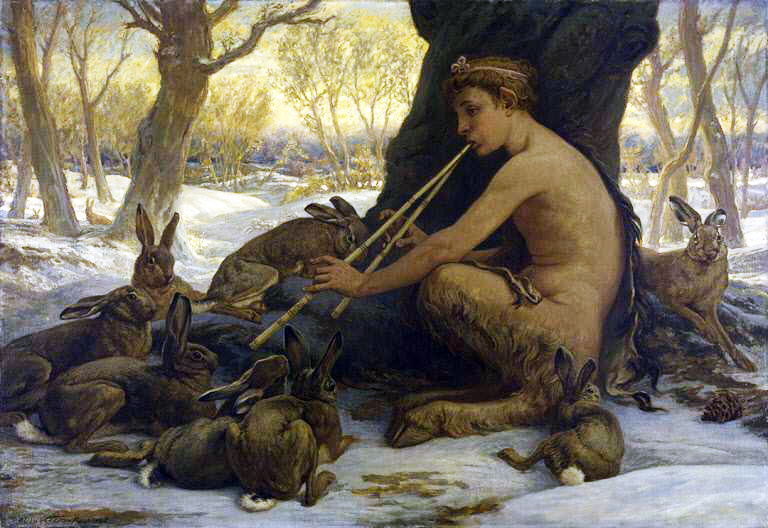February 26 is the birthday of Elihu Vedder (1836 – 1923), an American artist whose playful painting, Young Marsyas, is on view in Crystal Bridges’ Early Nineteenth-Century Gallery.
Vedder was born in New York City in 1836. Like many American artists of the nineteenth century, he studied in Rome, where he settled permanently in 1865. The wealth of classically inspired art in Rome—on view in museums, galleries, and on the street—offered inspiration to Vedder and fellow American artists.
Young Marsyas represents Vedder’s interest in imaginative themes grounded in the natural world. The subject is based in Greek mythology. Marsyas was a satyr (half man, half goat) who challenged the god Apollo to a contest of musical skills. While he practiced, Apollo made the trees and stones come to hear him play his lyre (an ancient Greek instrument similar to a harp), so Vedder pictured Marsyas practicing his double flute for the hares. Tragically, Marsyas lost the contest and was flayed alive for his hubris, or extreme arrogance and defiance of a god. The luminous landscape where Marsyas practices is reminiscent of New England, although Vedder lived in Rome when he completed this painting.
Vedder exhibited Young Marsyas and one additional painting in the Paris Exposition in 1878 where it became a topic of critical debate. The painting initially attracted complimentary reviews, but then received harsh criticism from a French reviewer, who surprisingly singled out Vedder’s entries as examples of bad American painting. Ultimately, the praise for Vedder’s “inventiveness and originality” outweighed the negative reactions to Young Marsyas. Helen Hunt Jackson was so inspired by the painting that she penned a poem, “The Young Marsyas,” in 1880 (excerpted here):
The secrets that alone the south wind knew, By summer hid in green reeds’ jointed cells, To wait imprisoned for the south wind’s spells, From out his reedy flute the player drew, And as the music clearer, louder grew, Wild creatures from their winter nooks and dells, Sweet furry things, with eyes like starry wells, Crept wondering out; they thought the south wind blew.
In the late nineteenth century, Elihu Vedder was a well-known American artist. By the turn of the twentieth century, however, his artwork fell out of favor—Vedder’s style and subjects were not real enough to fit with the Ash Can School in New York, and not abstract enough for Modernism. Scholarship revived interest in Vedder and his artwork in the 1970s, but until recently, it was thought that Young Marsyas had been destroyed.
Young Marsyas, which was purchased at auction from a private collection, is an important addition to the Crystal Bridges collection—both as an exceptional example of Vedder’s work and as part of the larger story of American artists abroad and the influence of classical mythology on American art. Mindy Besaw is a Curator at Crystal Bridges






